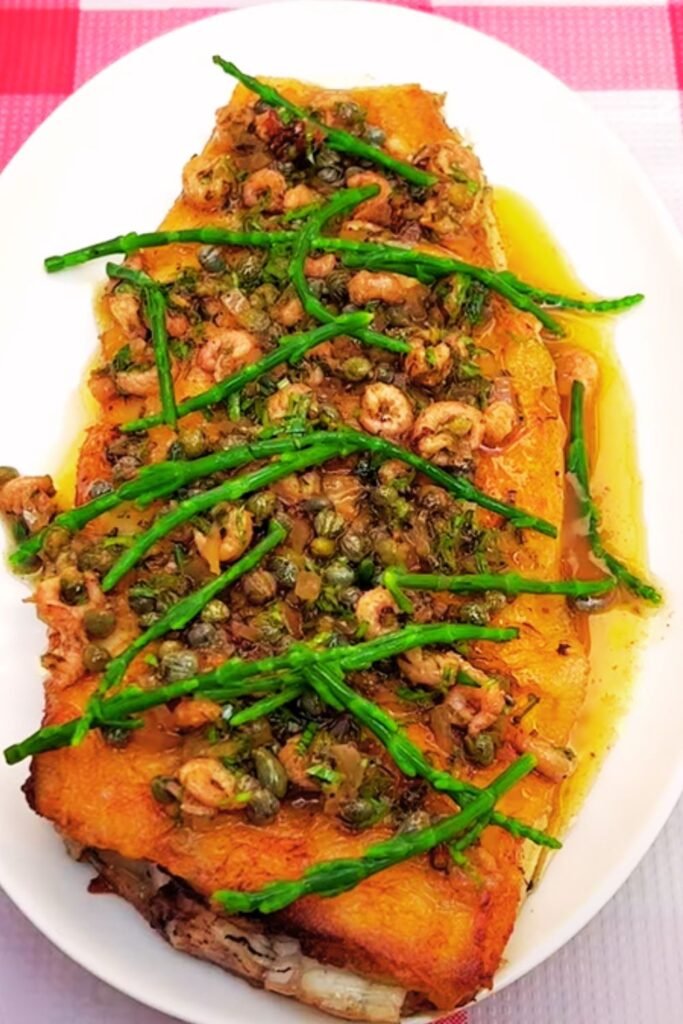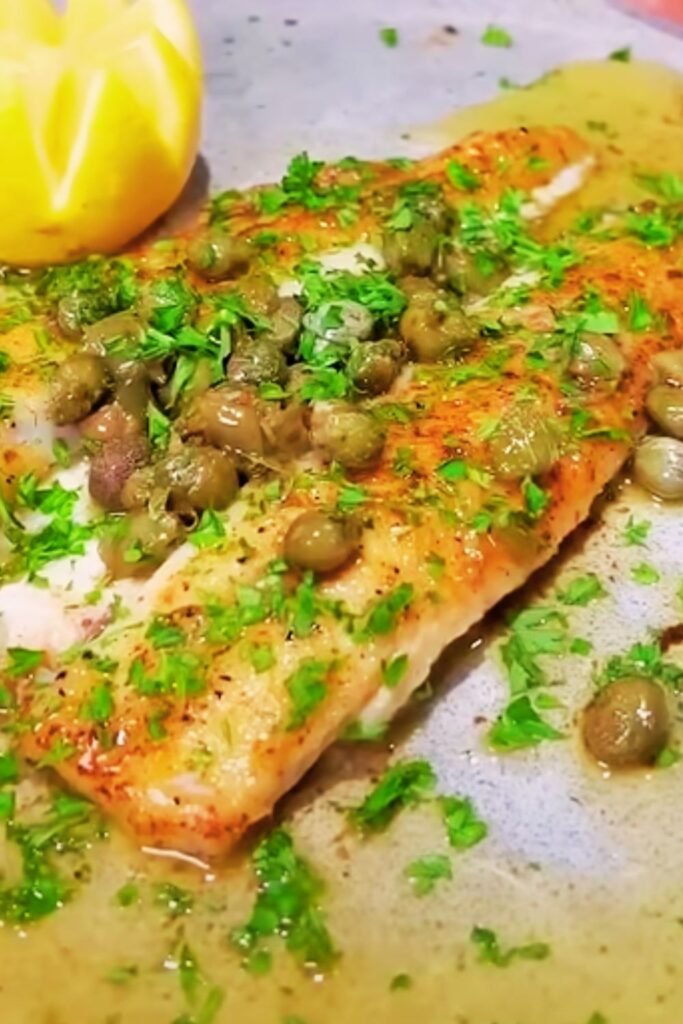When I first encountered Flounder Meunière in a small bistro in Lyon, I was struck by how something so seemingly simple could deliver such profound flavors. The delicate flounder, kissed with golden butter and brightened with fresh lemon, represented everything I love about French cuisine: technique, restraint, and the ability to let quality ingredients shine.
Flounder Meunière isn’t just a recipe; it’s a masterclass in French cooking fundamentals. The term “meunière” literally translates to “miller’s wife,” referring to the traditional technique of dredging fish in flour before pan-frying. This method creates a light, crispy coating that seals in the fish’s natural moisture while providing the perfect canvas for the iconic brown butter sauce.
Understanding Flounder: The Perfect Canvas for Meunière
Flounder : A flatfish characterized by its delicate, flaky texture and mild, slightly sweet flavor profile that absorbs accompanying flavors beautifully.
Meunière Style : A classic French cooking method involving flour-dredging, pan-frying, and finishing with brown butter, lemon juice, and fresh herbs.
Beurre Noisette : The French term for brown butter, created by cooking butter until it develops a nutty aroma and golden-brown color.
Flounder’s unique characteristics make it ideally suited for the meunière treatment. Unlike meatier fish such as salmon or tuna, flounder’s tender flesh requires gentle handling and quick cooking methods. The fish’s naturally mild flavor serves as an excellent backdrop for the rich, nutty notes of brown butter and the bright acidity of fresh lemon.
Essential Ingredients and Quality Considerations

The success of Flounder Meunière hinges entirely on ingredient quality. I’ve learned through countless preparations that shortcuts in ingredient selection inevitably compromise the final dish.
Selecting Perfect Flounder
| Quality Indicator | What to Look For | What to Avoid |
|---|---|---|
| Appearance | Clear, bright eyes; shiny, metallic skin; firm flesh that springs back when pressed | Cloudy eyes; dull, discolored skin; soft, mushy texture |
| Smell | Fresh ocean scent; no “fishy” odors | Strong, ammonia-like smells; sour or off odors |
| Texture | Firm, elastic flesh; intact skin without tears | Slimy surface; flesh that feels soft or separates easily |
| Freshness Timeline | Ideally caught within 24-48 hours | Fish older than 3-4 days from catch |
Core Ingredients Breakdown
| Ingredient | Quantity (4 servings) | Purpose | Quality Notes |
|---|---|---|---|
| Flounder Fillets | 4 pieces (6-8 oz each) | Main protein | Fresh, never frozen preferred |
| All-Purpose Flour | 1 cup | Creates crispy coating | Sift for smoothest texture |
| Unsalted Butter | 6 tablespoons | Brown butter sauce base | European-style for richness |
| Fresh Lemon | 2 large lemons | Acid balance and brightness | Room temperature for maximum juice |
| Fresh Parsley | 3 tablespoons, chopped | Color and fresh herb notes | Flat-leaf preferred for flavor |
| Sea Salt | To taste | Seasoning | Fine sea salt for even distribution |
| White Pepper | 1/2 teaspoon | Gentle heat without specks | Freshly ground for potency |
| Vegetable Oil | 2 tablespoons | Prevents butter burning | Neutral flavor, high smoke point |
Step-by-Step Preparation Method
Phase 1: Preparation and Setup
My approach to Flounder Meunière emphasizes mise en place—having everything perfectly organized before beginning the cooking process. This dish moves quickly once you start, leaving no room for scrambling.
Equipment Setup:
- Large, heavy-bottomed skillet (preferably stainless steel or cast iron)
- Fish spatula or thin, flexible turner
- Small saucepan for brown butter
- Shallow dishes for dredging station
- Paper towels for patting fish dry
- Warm serving plates
Fish Preparation:
- Remove flounder from refrigeration 15-20 minutes before cooking to bring to room temperature
- Pat each fillet completely dry with paper towels—moisture is the enemy of proper browning
- Check for any remaining bones by running fingers along the flesh
- Season both sides generously with salt and white pepper
- Allow seasoning to penetrate for 10 minutes while preparing other components
Phase 2: The Dredging Process

The flour coating serves multiple critical functions in this preparation. It creates a barrier that prevents the delicate fish from sticking to the pan, provides textural contrast, and helps the butter sauce adhere to the finished dish.
Dredging Station Setup:
- Station 1: Seasoned flour in shallow dish
- Station 2: Clean, dry plate for dredged fillets
- Station 3: Paper towels for cleanup
Proper Dredging Technique:
- Combine flour with additional pinch of salt and pepper
- Gently press each fillet into flour, ensuring complete coverage
- Lift and shake gently to remove excess flour
- Place on clean plate, avoiding overlap
- Use immediately—don’t let dredged fish sit longer than 5 minutes
Phase 3: The Pan-Frying Process
This phase requires attention and timing. The goal is achieving a golden-brown crust while maintaining the fish’s delicate interior texture.
Heat Management:
- Preheat skillet over medium-high heat for 2-3 minutes
- Add oil and allow to shimmer but not smoke
- Test temperature with flour pinch—should sizzle immediately
Cooking Sequence:
- Gently lay fillets in pan, presentation side down first
- Don’t move or disturb fish for first 3-4 minutes
- Watch for golden edges to indicate proper browning
- Flip carefully using fish spatula, supporting with free hand
- Cook second side 2-3 minutes until fish flakes easily
- Transfer to warm plates immediately
Phase 4: Brown Butter Sauce Creation

The brown butter sauce transforms this simple preparation into something extraordinary. This technique requires careful attention to prevent burning while achieving the perfect nutty flavor.
Brown Butter Process:
- Wipe pan clean of any flour residue
- Add butter over medium heat
- Swirl pan constantly as butter melts and foams
- Continue cooking until foam subsides and butter turns golden-brown
- Remove from heat immediately when nutty aroma develops
- Add lemon juice carefully—mixture will bubble vigorously
- Stir in fresh parsley and season with salt
Advanced Techniques and Professional Tips
Temperature Control Mastery
| Cooking Phase | Ideal Temperature | Visual Cues | Common Mistakes |
|---|---|---|---|
| Initial Searing | Medium-high (375-400°F) | Oil shimmers, flour test sizzles | Too hot: flour burns; too cool: no browning |
| Fish Cooking | Medium (325-350°F) | Gentle sizzling, no violent bubbling | Rushing with high heat creates tough exterior |
| Brown Butter | Medium (300-325°F) | Steady bubbling, color progression | High heat causes burning, bitter flavors |
Timing Coordination
The key to perfect Flounder Meunière lies in orchestrating multiple elements simultaneously. I’ve developed this timeline through years of practice:
T-minus 20 minutes: Remove fish from refrigeration, season, begin setup T-minus 10 minutes: Heat pan, prepare dredging station, warm plates T-minus 5 minutes: Dredge fish, final equipment check T-0: Begin cooking fish T+6 minutes: Fish should be plated, begin brown butter T+8 minutes: Sauce complete, dish ready for service
Nutritional Profile and Health Benefits
Flounder Meunière offers impressive nutritional value alongside its culinary appeal. Understanding these benefits helps appreciate this dish beyond mere taste.
Comprehensive Nutritional Analysis
| Nutrient | Per Serving (6 oz fillet) | Daily Value % | Health Benefits |
|---|---|---|---|
| Protein | 42g | 84% | Muscle maintenance, satiety |
| Omega-3 Fatty Acids | 0.8g | – | Heart health, brain function |
| Vitamin B12 | 2.4mcg | 100% | Nervous system support |
| Selenium | 28mcg | 51% | Antioxidant protection |
| Phosphorus | 340mg | 27% | Bone health |
| Potassium | 480mg | 14% | Blood pressure regulation |
| Calories | 285 | 14% | Moderate calorie density |
| Fat | 12g | 18% | Primarily from healthy butter |
Health Considerations
Flounder provides exceptional protein quality with all essential amino acids in optimal ratios. The fish’s low mercury content makes it suitable for regular consumption, while the preparation method preserves delicate nutrients that harsh cooking might destroy.
The butter component, while adding calories, contributes fat-soluble vitamins A, D, E, and K. When consumed as part of a balanced meal with vegetables, this dish provides sustained energy and satisfaction.
Serving Suggestions and Accompaniments
The elegance of Flounder Meunière shines when paired thoughtfully with complementary sides that don’t compete with the dish’s delicate flavors.
Classic French Accompaniments
Pommes de Terre Vapeur (Steamed New Potatoes) Small, waxy potatoes steamed until tender and tossed with butter and herbs provide the perfect starchy complement without overwhelming the fish.
Haricots Verts Almondine Thin French green beans quickly blanched and sautéed with sliced almonds echo the dish’s brown butter notes while adding textural variety.
Simple Mixed Greens A light salad dressed with lemon vinaigrette cleanses the palate and adds freshness to balance the rich butter sauce.
Modern Interpretations
Roasted Asparagus with Lemon Zest Thick asparagus spears roasted until just tender and finished with fresh lemon zest complement the fish’s lemony notes.
Wild Rice Pilaf Nutty wild rice cooked in vegetable stock with herbs provides earthiness that grounds the dish’s bright flavors.
Sautéed Spinach with Garlic Quick-cooked spinach with garlic adds iron and vitamins while maintaining the meal’s elegant simplicity.
Troubleshooting Common Issues
Through years of teaching this technique, I’ve identified the most frequent problems home cooks encounter and developed reliable solutions.
Problem Resolution Guide
| Issue | Likely Cause | Prevention | Solution |
|---|---|---|---|
| Fish Sticks to Pan | Insufficient oil, moving too early | Proper preheating, patience | Use fish spatula, don’t force |
| Burnt Flour Coating | Temperature too high | Medium-high heat only | Lower heat, watch carefully |
| Soggy Coating | Wet fish, crowded pan | Pat dry, cook in batches | Start over with dry fish |
| Bitter Brown Butter | Overcooked butter | Watch color, smell changes | Discard, start fresh |
| Broken Sauce | Temperature shock | Gradual temperature changes | Whisk in cold butter |
| Overcooked Fish | High heat, too long | Gentle heat, visual cues | Check doneness frequently |
Storage and Reheating Guidelines
While Flounder Meunière tastes best served immediately, proper storage techniques preserve quality for later enjoyment.
Refrigeration:
- Store leftover fish and sauce separately
- Use within 24 hours for best quality
- Cover tightly to prevent odor absorption
Reheating Method:
- Preheat oven to 275°F
- Place fish on baking sheet
- Heat 8-10 minutes until warmed through
- Prepare fresh brown butter sauce for serving
Seasonal Variations and Creative Adaptations
While traditional Flounder Meunière remains perfect as written, seasonal adaptations keep this classic feeling fresh throughout the year.
Spring Variation
Add fresh peas and mint to the brown butter sauce for a bright, seasonal twist that celebrates spring’s arrival.
Summer Adaptation
Incorporate fresh tomatoes and basil, reducing the butter slightly to let summer vegetables shine.
Fall Enhancement
Include toasted hazelnuts and sage in the brown butter for an autumnal richness that pairs beautifully with root vegetable sides.
Winter Comfort Version
Add capers and fresh thyme to create a more robust flavor profile suitable for cold weather dining.
Questions and Answers
Q: Can I substitute other types of fish for flounder in this recipe? A: Absolutely! Sole, plaice, or any delicate white fish works beautifully with this technique. The key is choosing fish with similar thickness and cooking time requirements. Avoid thick, meaty fish like halibut or cod, as they require different cooking approaches.
Q: How do I know when the brown butter is perfectly done? A: Perfect brown butter develops a deep golden color and releases a distinctly nutty aroma. The butter will foam initially, then the foam will subside as water evaporates. When you see golden-brown specks and smell the nutty fragrance, remove it from heat immediately. The whole process takes about 3-4 minutes.
Q: What’s the secret to preventing the fish from falling apart when flipping? A: The key lies in proper preparation and timing. First, ensure your fish is completely dry before dredging. Second, don’t move the fish until it’s properly seared—the protein will release naturally from the pan when ready. Finally, use a thin, flexible fish spatula and support the fish with your free hand while flipping.
Q: Can I prepare any components of this dish ahead of time? A: You can season the fish up to 2 hours ahead and keep it refrigerated. The dredging should happen just before cooking. However, both the fish cooking and brown butter sauce must be done immediately before serving for best results.
Q: Why does my flour coating sometimes become gummy or thick? A: This usually happens when the fish isn’t completely dry before dredging, or when too much flour accumulates. Always pat fish thoroughly dry, shake off excess flour after dredging, and avoid letting dredged fish sit too long before cooking.
Q: How can I tell when the flounder is perfectly cooked? A: Properly cooked flounder will be opaque throughout and flake easily when tested with a fork at the thickest part. The internal temperature should reach 145°F, but visual and textural cues are more reliable for delicate fish like flounder.
Q: What should I do if my brown butter sauce breaks or separates? A: If the sauce breaks, remove it from heat immediately and whisk in a tablespoon of cold butter. This helps re-emulsify the mixture. If it’s severely broken, start over—brown butter sauce is quick to make and the results are worth the extra effort.
Q: Can I make this dish for a large dinner party? A: While possible, Flounder Meunière is best prepared for smaller groups (4-6 people) to maintain quality. If cooking for more, work in batches and keep finished fish warm in a low oven while preparing additional portions. The brown butter sauce should be made fresh for each batch.
This classic French preparation continues to captivate me with its perfect balance of technique and simplicity. Every time I prepare Flounder Meunière, I’m reminded why certain dishes achieve timeless status—they represent the very best of culinary tradition while remaining accessible to passionate home cooks. The transformation of humble ingredients into something truly memorable through proper technique embodies everything I love about cooking.
Whether you’re preparing this dish for a special occasion or simply wanting to elevate a weeknight dinner, Flounder Meunière offers the perfect opportunity to practice fundamental French cooking skills while creating something genuinely delicious. Take your time, focus on quality ingredients, and trust the process—the results will speak for themselves.